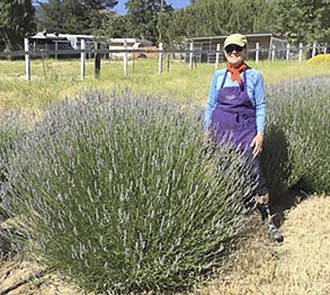By Christi Baron
Forks Forum Editor
When Gayle Mousis and Terry Penrose went looking for a place to get away and grow lavender they naturally thought of Sequim. They already had a lavender farm in California so they knew what they were doing. Gayle also ran a New York-style deli where they lived but they were looking for a place to breathe.
Never having been to the Olympic Peninsula before they started their search in Sequim where lavender grows well … they even have a “little” festival there in Sequim that draws crowds of people! Not seeing exactly what they wanted, their real estate agent told them that he had a lavender farm in Forks. He didn’t really have lavender farm — he had a dahlia farm — and like any good real estate agent worth his commission he made an appointment right away to have them look at it.
Gayle said she remembers feeling really bad, going to look at the property on such short notice and really with little intention of probably purchasing it. But she said as she and Terry began to look at the property it was perfect. When they finished looking they made an offer and much to their surprise it was accepted and so began Lebec Oaks Lavender, the Washington state division.
If Gayle has her way, one day people will leave the Sequim Lavender Festival and continue driving to Forks where they will be able to enjoy even more lavender. Lavender grows well in Forks and elk and deer don’t eat it! A good thing since the farm is located next to an elk preserve. The only problem with growing lavender is it can be over watered which could be a problem with our rainfall but according to Terry, it’s not a problem if planted with the correct drainage. A plant can live about 20 years.
Gayle and Terry have turned the former 8.5 acres of dahlia farm into a lavender farm in just two years. The former outbuildings that dried dahlia tubers now dry lavender. It does take a little longer to dry it here but once dry the petals are removed and every part of the plant is used for something. The bare stems are used when starting an outdoor fire or just a few are burned to repel mosquitoes and other bugs. Once the petals are distilled they go back in with the chickens as bedding.
Speaking of distilling, a small still separates the lavender oil from the hydrosol, which is the flower water, which Gayle claims is great on stainless steel appliances. Lavender is also antibacterial, antifungal, carminative (smooth muscle relaxing), sedative, anti-depressive and effective for burns and insect bites.
Terry said they pride themselves on the purity of the products they make, using no synthetics. Also, their culinary grade lavender is first purified with a UV wand. “When we went to France and watched them process the lavender, they threw everything in; the stocks, the bugs, everything,” Terry said.
Gayle said that the industry is not regulated so some people take advantage of that but not Gayle and Terry, “What we do is really clean and pure,” she added.
From one pound of lavender petals, 1.5-2 ounces of oil are produced. It takes about 45 minutes for the still to get up to temperature for the first batch and then things go quicker after that. Gayle said they are currently having a web page designed to showcase the different products they produce from lavender.
Most Saturdays you can find Gayle selling her lavender products at the Forks Open Aire Market at Umpqua Bank. Except for last Saturday … she was at the Lavender Festival in Sequim.



